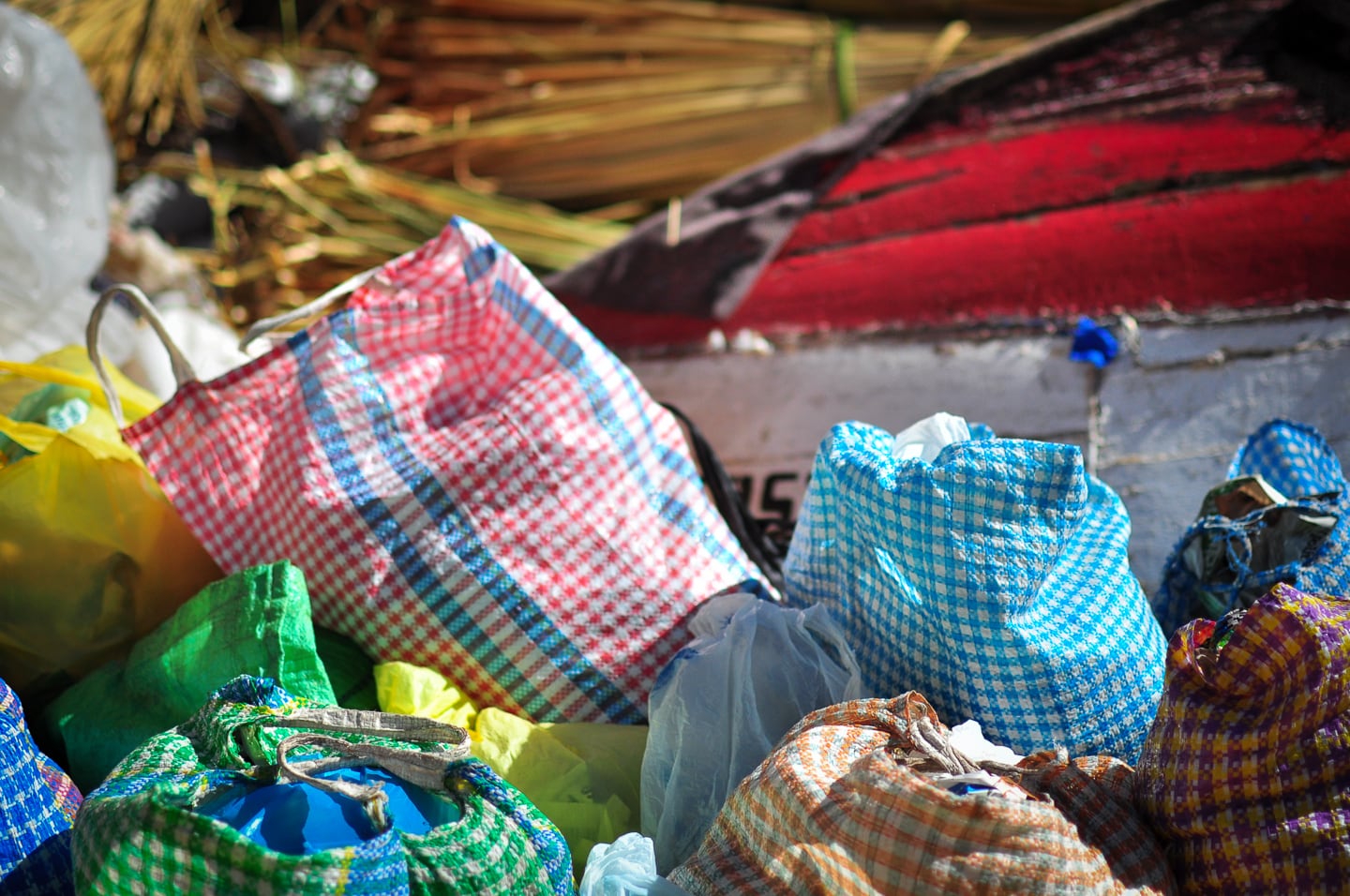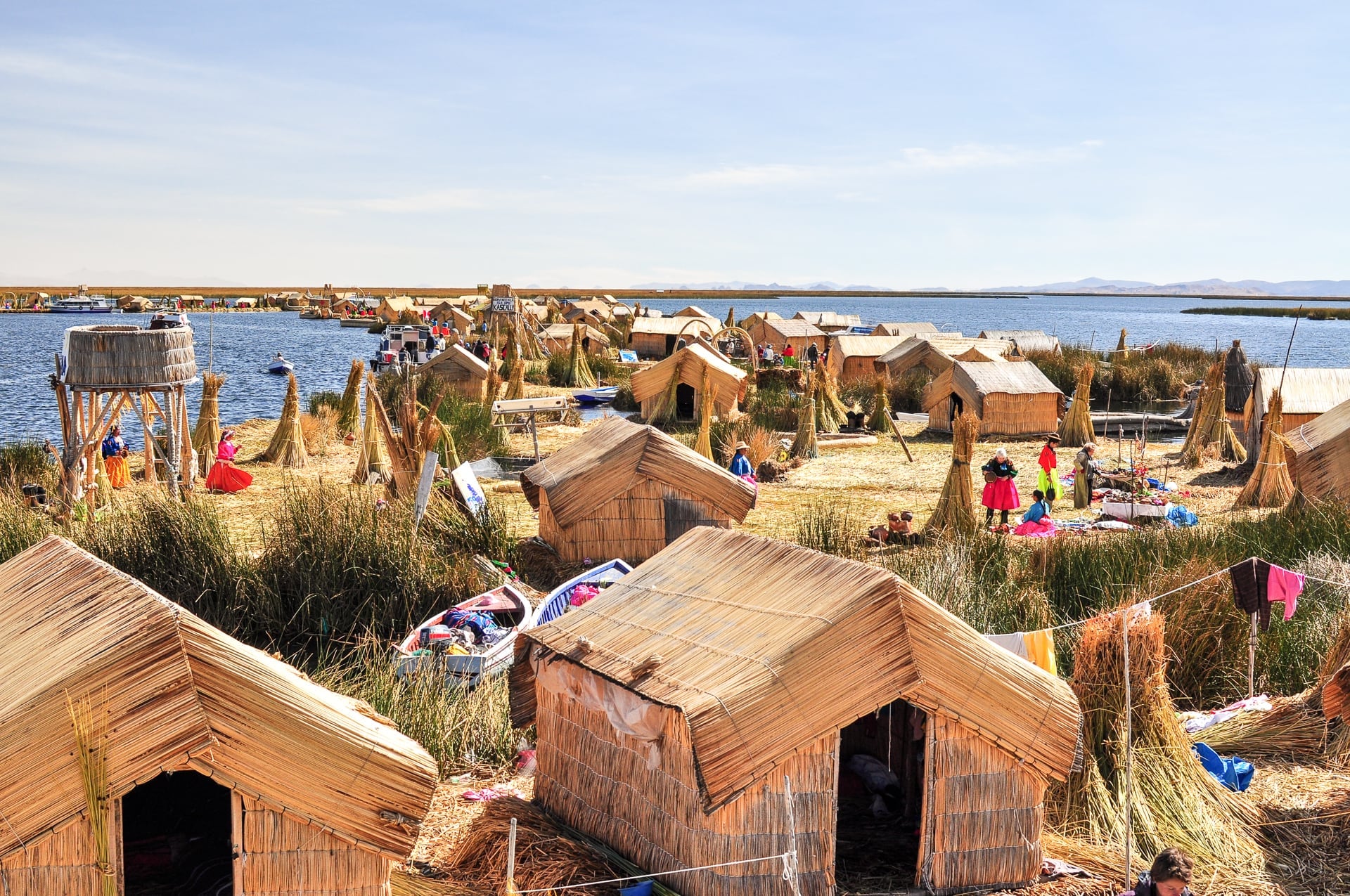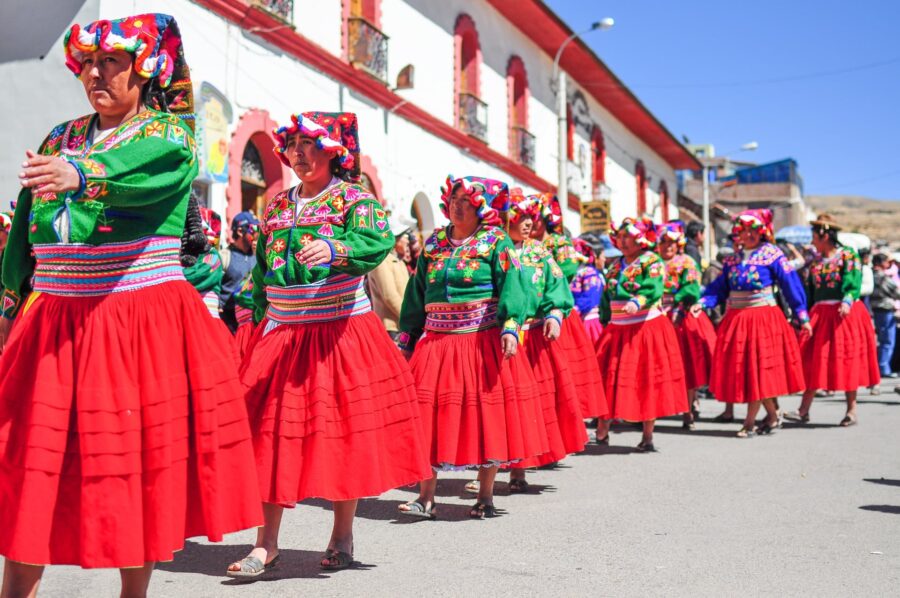It’s a Thursday here on the islands of the Uros, and folks are doing what they do most other days of the week: gathering, packing or weaving totora, a type of reed found chiefly on Lake Titicaca and Easter Island in the Pacific.
Totora is, first and foremost, a building material, and the Uros use it to construct everything from houses to boats to the island itself.
Yep, you heard right, the island we’re standing on—and its 43 neighbors—are made entirely of cut, dried and packed grass.
But we’ll get to that in a moment.

After four days of walking the Inca Trail and arriving at Machu Picchu, we took the San Luis bus (most long-distance buses in Peru are nice, late-model double-decker buses) from Cuzco down to Puno on the banks of Lake Titicaca.
It was a longer travel day (about 8 hours on the bus), but really not that long by Peru standards.
Peru, as you may have noticed by now, is a very large and very mountainous country serviced by a rudimentary and aging road network.
The landscape along the way was stark and monotonous for much of the journey, save for the occasional family cluster or community along the highway.
It must take one hell of a hardy soul to survive in this arid and unforgiving landscape, with very limited access to resources, hundreds of miles away from the next urban area.

By the way, that horizontal line in the picture above is the Cuzco-Lake Titicaca railway.

Our original plan was to ride the rails here, but it seems passenger service has been halted for the moment.
I can only imagine what it must be like when a mile-long freight train comes barreling through here, cutting through the stillness of the valley like a jackhammer in a monastery.

While we only gained just over 1,000 feet in elevation from Cuzco, we entered a whole other climate.
Even at two miles high and in the depths of the Southern winter, Cuzco maintained daytime highs of around 80F and nighttime lows around 65F.
Puno, however, is another story.
Midday sees temps around 65F, but evenings…yeeeaaah.
Let’s just say we were equipped for cooler weather, but not for temperatures in the teens.
Even in the daytime the difference between standing in direct sunlight and a few feet over in the shade can be as much as 20 degrees. Yep, it’s a whole new ballgame.

“ResponsaLisa”…so careless…always missing the company…

We rolled into town, spent a good while hoofing our packs around town before finding a room, and set out the next morning on a ferry to the lake islands! Which brings us to the Uros.

I’d like to say that we arrived on something like this (above), but in reality getting to the islands involved a one-hour ride on the white and blue motor-ferry you see in the background.
The Uros islands were actually a regularly scheduled stop on the way to the island of Amantani, our final destination for the day. We had about an hour to stroll around before continuing on.
Believe it or not, much larger ferries than ours ply these waters — the largest being the 260-foot long SS Ollanta, which was constructed in England, shipped to Peru, disassembled and transported, piece by piece (all 2200 tons), 260 miles overland from the Pacific Ocean to an elevation of 12,000 feet — then reassembled on the lake.
That was 1931.
The SS Ollanta is still in service today, and it doesn’t take much imagination to figure out why.


Upon arrival, we disembarked from the ferry and were astonished to find this:

Of the 44 islands of the Uros, apparently there are only a select few that host foreign visitors.
And while the vast majority of Uros people do go about their daily lives doing more “traditional” activities (involving reeds, perhaps?), families take turns working the tourist islands, selling trinkets (not generally made on the islands), and locally-made textiles.
Others perform demonstrations of daily activities, such as this woman who is grinding corn.


The Uros people originally constructed the islands to defend themselves from mainland marauders.
The reed islands were built a great distance from shore communities and could be moved if a threat arose.
Watchtowers still remain, some of which (like the one above) are built completely from reeds.
Visitors are permitted to climb one of the towers which offers a commanding view of the settlement.


Another tower advertises propane, gasoline, and the only restaurant on the island.

At one point, our boat captain made an announcement that someone was going to do a demonstration on how the islands are constructed, which is a process that never ends.
New islands are originally created by digging out reeds with the dense root structure intact (the brown blocks below), and anchoring them with ropes to the bottom of the lake.
The original layer of reeds rot and new reed is cut and laid over to replace it. New layers are added every 15 days perpendicular to the existing reed layer.
At any given time, the ground is about 2 meters thick (1 meter of reed and 1 meter of root).
The average lifespan of one of the reed islands is said to be about 15-20 years.

Residents must constantly be moving their homes as new reeds are added. Cooking fires are made atop large stones, and latrines are built into the islands themselves so that the base absorbs the waste rather than passing through into the water).

However, not everything on the island is made out of reeds…


It was a surreal stop, to say the least—certainly a bit more touristy than we had envisioned, but all good fun.
The oddest part of our visit, however, had to be one particular group of brightly-dressed local women serenading a group of foreigners sitting atop a reed boat with “Row, Row, Row Your Boat” in broken English.
I’m not certain what any of the participants stood to gain from this exchange, particularly the women, but I will say that it’s perhaps the most rousing rendition I’ve ever heard performed live in Latin America.

But seriously, there’s good money to be made from these tourist visits, which have become a lifeblood for the Uros communities here.
If it weren’t for tourism, it’s hard to imagine these people continuing their unique way of life for much longer.
For all its ills, tourism can be a net positive for indigenous communities, so long as the communities, themselves, get to determine the rules and are the primary beneficiaries of their efforts.
A few minutes spent singing “Row, row, row your boat” to a bunch of gringos in a boat might not seem dignified at first, but if it’s the women’s choice and it enables them and their families to otherwise live in the manner they wish to live and maintain their cultural heritage, I think that’s got to be one of the more dignifying lines of work out there.

This all bears mentioning that only a tiny fraction of Uros descendants remain on the islands today.
While the vast majority have relocated to the mainland and assimilated into greater Peruvian society, only a few hundred continue to live afloat on the water, the way their people have for generations.


When we first arrived on the island, some local women asked us if we wanted to go on a boat ride. They announced the price, which seemed a bit steep, so we declined and moved on to other things.
We didn’t bother haggling because we were more interested in exploring the island than getting back on a boat.
Well, about 20 minutes later, the women announced a discount. Half price! Nearly everyone else on our boat who hadn’t taken the boat ride flocked over to women…except us. We were too busy shopping for a colorful wall-hanging to take with us.
With 15 minutes left, the women announced one last time: An additional half-off!
Well, that did it. They finally convinced us…the last two holdouts on the island. At this point, they were practically giving away the boat rides.
We hurried over to the reed boat and climbed aboard.



In the end, the boat ride was definitely worth it—though I’m sure the first round of passengers must have been kicking themselves.
In all honesty, though, they did get a much more pimped-out ride than our little canoe:





Not your typical morning, I’d say.
Back on the boat and bound for the mysterious and remote island of Amantani!




